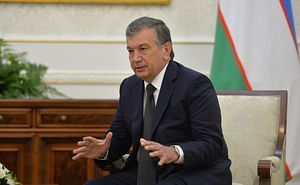By Monday, Uzbekistan will have a new president — something that hasn’t happened for longer than Uzbekistan has been an independent state. Islam Karimov became president of the Uzbek Soviet Socialist Republic in March 1990 and declared the state’s independence on September 1, 1991. Twenty-five years and a day later, if the official date of September 2, 2016 is believed, he died at the age of 78.
Things will have taken a very wild turn if the victor emerging from the December 4 election is anyone but acting President Shavkat Mirziyoyev. Mirziyoyev has been prime minister since 2003. Following Karimov’s death, the chairman of the Senate, Nigmatilla Yuldashev, should have become interim president, per the state’s constitution. But Yuldashev demurred, citing Mirziyoyev’s “many years of experience,” and proposed Mirziyoyev take over as interim president until elections could be organized.
The looming election is staged in similar fashion to previous elections, which always delivered the expected outcome: a re-coronation of Karimov. Uzbekistan last had a presidential election in March 2015. Karimov received over 90 percent of the vote. The Organization for Security and Cooperation in Europe’s Office for Democratic Institutions and Human Rights (OSCE/ODIHR) said in its final election observation report that the campaign was “lackluster” and that “none of the other three presidential candidates questioned the incumbent’s policies and achievements.”
In the upcoming election, Mirziyoyev was formally nominated by the Liberal Democratic Party of Uzbekistan (LDPU), which had always offered up Karimov as its candidate. Khatamjan Ketmonov (People’s Democratic Party), Narimon Umarov (Social Democratic Party), and Sarvar Otamuratov (National Revival Democratic Party) are the other candidates — both Ketmonov and Umarov ran in the 2015 election, pulling 2.9 and 2 percent of the vote, respectively.
With regard to the 2015 election, the OSCE’s final report said, “In the absence of a political debate or genuine competition, the campaign was a background to a process centered on the incumbent, who appeared as an unchallenged guarantor of peace and stability for the country and the region.” The candidates refrained from criticizing the state, Karimov, or each other.
The OSCE’s interim report, published November 24, called the current campaign “moderately visible.” Laws ensure equal access, with each candidate having “642 billboards displayed across the country and equal access to 36 electronic screens to broadcast campaign messages.” As in 2015, the candidates have not criticized the state or each other.
On the surface, a “moderately visible” campaign seems an improvement. But according to the 2015 interim report, “[e]ach candidate was given access to 829 billboards to be used across the country.” If billboard access is the a measurement of campaign visibility, then the 2016 election campaign is less visible. If 2016’s campaign is more visible, it is mostly because Karimov is not running — a true novelty in Uzbek elections.
The candidates may be touring more widely — and reaching more voters thanks to the use of video-conferencing — but this too, is not all that exciting.
The OSCE’s 2015 interim report noted that “each candidate’s platform focuses on a specific segment of the population and prioritizes targeted electorate’s interests.” Karimov had dibs on economic reforms, Ketmonov’s pet topic was social protection, Umarov had judicial reforms, and the National Revival Democratic Party’s candidate, Akmal Saidov focused on national values and traditions.
Per EurasiaNet’s analysis, this time around Ketmonov’s platform has rested on promoting “social equality” with a focus on the disabled; Umarov’s focus has shifted to education; and Otamuratov seems to be taking his party’s name seriously and honed in on the “idea of ‘national renewal,’ and the idea of bolstering greater national self-awareness.”
Mirziyoyev, EurasiaNet notes, “has the most detailed campaign platform of all.” Like Karimov, Mirziyoyev seems to be focusing on economic issues: private enterprises and foreign investment, pledging to double Uzbekistan’s GDP by 2030.
The OSCE’s 2016 interim report notes that “[t]he prevalent campaign discourse stresses continuity and stability during this unprecedented transition of power.”
The real question is not whether Mirziyoyev will win the election, but whether any of the nascent signs of progress so far are the genuine article or, more likely, a smokescreen designed to buy the new president some goodwill both domestically and internationally. Mirziyoyev has taken some positive steps in his interim role, not the least of which is outreach to the neighboring states. Exchanges of delegations with Kyrgyzstan and Tajikistan, and seeming movement on reintroducing flights between Tashkent and Dushanbe for the first time since 1992, are all good, neighborly, diplomatic moves. The same can be said of progress on border demarcation with Kyrgyzstan and Kazakhstan. The recent release of a long-held political prisoner is another positive mark.
Many of these positive notes are on Uzbekistan’s external fronts; but what about internal dynamics? Mirziyoyev relaxed residency restrictions and his office set up an online portal to take citizen complaints, but these can just as easily be read as PR moves and not indicative of genuine reforms.
If regional history is any guide, we ought to place bets not on who will win the election but by how much Mirziyoyev will win. And for the time being, it’s prudent to remark on hopeful glimmers of progress but refrain from singing Mirziyoyev’s praises too loudly.
































